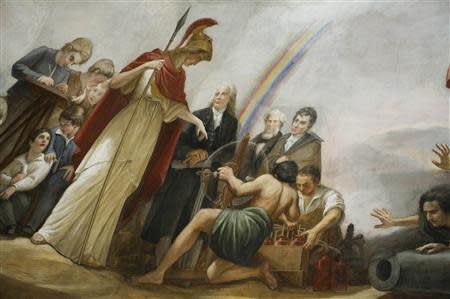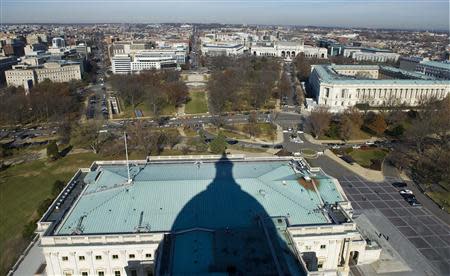U.S. Capitol faces massive overhaul - and not via the ballot
By Patricia Zengerle WASHINGTON (Reuters) - Americans longing for a makeover in Washington will get their wish partially granted as the dome of the U.S. Capitol - but not the lawmakers who work inside - undergoes a $60 million restoration. After 150 years of exposure to rain, snow, sun and sleet, the cast-iron landmark is suffering from water leaks, cracks and corrosion that urgently need repair, Stephen Ayers, the Architect of the Capitol, said on Thursday. "A dozen years ago there were 300 and some cracks, a few more years there were 500 cracks, then 900 cracks, and now 1,300. Now is the time to intervene and make sure it's preserved for generations to come," he said at a news conference announcing the launch of the dome restoration project, standing beside a table bearing more than three dozen corroded pieces of cast iron from the massive structure. While Americans' view of Congress is negative - polls have the legislature's approval rating in the single digits - the sprawling white building is a beloved symbol and tourist spot visited by thousands of people daily through much of the year. The dome will be covered with scaffolding during much of the restoration, which is expected to take two years. Planners are determined to finish before January 20, 2016, when the next president of the United States will be inaugurated on a platform erected on the Capitol's west front. The project is hugely complicated. The dome is 290 feet high and weighs 14.1 million pounds. Workers will be removing up to 13 layers of lead-based paint before they can reseal, prime and repaint the gleaming white structure. The cast iron will also be repaired and reinforced, and many elements - like floral decorations and cracked columns - will be removed in order to be fixed. This is all complicated by the dome's height, elaborate decoration and age. "The foundry practices in the 1850s and 1860s aren't as controlled as they are today," Kevin Hildebrand, head of the Capitol's architecture division, said. The scaffolding must also be lit because much of the renovation will take place at night to avoid disrupting the work of Congress. BLAME THE BIRDS Inside the soaring dome, workers will hang a doughnut-shaped safety net that will not obstruct the view of the "Apotheosis of Washington" fresco on the ceiling from the rotunda. That fresco, which took a year to paint, has already sustained some water damage, Ayers said. Hildebrand said a "defunct" bird-proofing system - wires painted white - would also be removed and replaced with a modern system. Bird damage led to monitoring that eventually prompted the current restoration, he told reporters during a visit to the viewing deck atop the dome. In 1990, a heavy downpour caused a leak so bad that water accumulated on the rotunda floor - from a hole made to accommodate a nest. "It was clear that the culprit was birds nesting in the upper level," Hildebrand said. The dome has not had major repairs in more than half a century, but planners have learned from the past. For example, Hildebrand said, welding during the last renovation - from 1959-1960 - has since failed. This time repairs of the cast iron will be via "lock and stitch," a mechanical repair involving drilling and pins. Ayers said he felt good about the chance of finishing on time and under the $59.55 million budget. He noted that a $20 million project to repair the dome's skirt finished in September on schedule and at the predicted price. "Guarantee? That's a big word," he said, when asked about the outlook for a similar performance on the larger project. "But we're pretty confident," he said. (Reporting by Patricia Zengerle; Editing by Phil Berlowitz)







